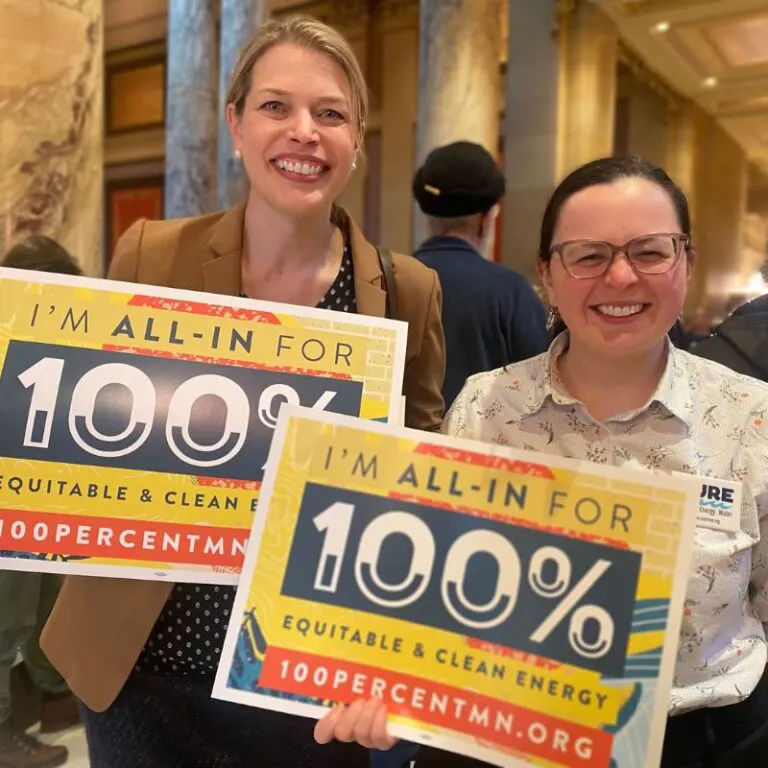The 100% Clean Energy Act sets Minnesota on the path of clean and renewable energy that will save Minnesotans money, increase electric grid reliability, and create good rural jobs. We are protecting and preserving what we love most about Minnesota and looking out for our kids and grandkids.
100% Clean Electricity from the sun and wind—
- Wind and solar energy purchased through power purchase agreements are below the projected cost of burning natural gas in gas-fired combined cycle units, according to the U.S. Department of Energy’s Land-Based Wind Market Report: 2022 Edition.
- The cost of solar energy is expected to be cheaper than wind within 5 years, by 2027, according to the U.S. Energy Information Administration’s Levelized Costs of New Generation Resources in the Annual Energy Outlook 2022.
- New wind and solar energy facilities are less expensive to operate than the cheapest existing coal-fired power plants, according to Renewable Power Generation Costs in 2020 by the International Renewable Energy Agency.
- As of 2018, 42% of existing coal power plants were operating at a loss, according to the report Powering Down Coal by Carbon Tracker, an independent financial think tank. Assuming no policy changes, 72% of existing coal power plants will be operating at a loss in 2040.
- A 2018 study commissioned by the McKnight Foundation found that we could achieve over 90% renewable energy by 2050 using current technology, while saving consumers $600-$1,200 per year.
- Ending the combustion of fossil fuels and biomass will reduce both GHG pollution and the emission of fine particulate matter like nitrogen oxides (NOx), sulfur dioxide (SO2), particulate matter, and heavy metals.
- The Minnesota Department of Health (MDH) found in their Life and Breathe report that in 2013 fine particle pollution contributed to 2,000 to 4,000 deaths in Minnesota, 300 respiratory hospitalizations, 140 cardiovascular hospitalizations, and 525 asthma-related emergency room visits. They estimated that up to 10% of early deaths are in part due to fine particulate pollution.
- MDH found that “a reduction in 10% in 2013 fine particle pollution levels could prevent up to 500 deaths, 50 hospitalizations, and 60 emergency room visits”.
- Decarbonizing our electric sector will have an impact. A recent report by PSE Healthy Energy found that retiring the Cohasset, MN-based Boswell Unit 3 by 2025 and Unit 4 by 2030 would save approximately 17-19 lives and reduce approximately $200 million in costs from adverse health impacts.
- There were 57,931 clean energy jobs in MN, as of 2021 — including jobs in energy efficiency, renewable electricity generation, advanced transportation, and clean fuels, and advanced grid.
- Solar industry jobs more than doubled this rate, growing by 9.7% in 2021.
- 69% of clean energy businesses in Minnesota are small businesses, with fewer than 20 employees, according to Clean Energy Economy Minnesota’s 2022 report.
- MN is home to the largest solar construction contracting company in the U.S. (Blattner Company in Avon, MN) and the two top wind energy builders in the country, Mortenson in Minneapolis, MN and Blattner Company.
- More than $12 million in wind energy production tax was paid in 2018 in Minnesota.
- To reach our pollution reduction goals and lower our costs, we need to expand and improve our transmission system.
- The 100% Clean Energy Bill will make it easier to site, interconnect, and operate wind and solar facilities.
- The bill makes changes regarding the siting of renewable facilities, small-scale transmission tie lines, and the coordination of work between the Public Utilities Commission and the Department of Commerce.
- Recent energy system modeling by Vibrant Clean Energy, LLC found that: “a high penetration of renewable energy and energy storage deployments will not threaten the reliability of the electric grid, while still providing service at prices less than current costs.”
- Minnesota’s climate is warming faster than most other U.S. states. Over the last 120 years, Minnesota’s annual average has increased by about 2.3°F, well over the U.S. average of 1.8°F.
- Currently, we’re not on track to hit Minnesota’s statutory goal of reducing economy-wide GHG emissions 80% below 2005 levels by 2050.
- Our interim NGEA goal was to reach a 15% reduction of economy-wide GHGs below 2005 levels by 2015. As of 2018, we had only reduced them by 8%, according to the Minnesota Pollution Control Agency’s Greenhouse gas emissions inventory, 2005-2018.
- In order to limit global warming to 1.5°C, the Intergovernmental Panel on Climate Change (IPCC) established the goals of reducing economy-wide emissions 45% (from a 2010 baseline) by 2030 and reaching net-zero by 2050 in their 2018 Special Report on Global Warming of 1.5°C.
- The average cost of homeowners insurance for Minnesotans increased 366% between 1998 and 2015. In 2010, for the first time, our state’s annual average cost exceeded the national average, moving Minnesota from having the 35th highest rates in 1998 to the 14th highest rates in 2015, according to Mark Kulda of the Insurance Federation of Minnesota.
- Corn and soybean crop yields decline with rising temperatures, according to Dr. Peter Reich, Department of Forest Resources, University of Minnesota.
- If we reduce our GHG emissions, Minnesota is on track to lose our boreal forests in the state by 2070, according to Lee Frelich, the director of the University of Minnesota’s Center for Forest Ecology.
- To reach 80% economy-wide decarbonization by 2050, Minnesota will need to decarbonize its electric sector by at least 91% from 2005 levels, according to a 2018 report by Vibrant Clean Energy LLC.

This 100% Clean Energy Law raises Minnesota’s Renewable Energy Standard and creates a new Carbon Free Standard that would require all of Minnesota’s utilities to produce carbon-free electricity by 2040. It has two main parts:
55% by 2035
Renewable electricity includes solar, wind, hydroelectric facilities, hydrogen, and certain types of biomass, not including large garbage incinerators that emit pollution in areas of concern for environmental justice.
80% by 2025
90% by 2035
100% by 2045
Carbon-free sources must generate electricity without emitting carbon dioxide. This includes renewable energy and also electricity from sources like nuclear energy that do not produce any carbon but are not renewable.


